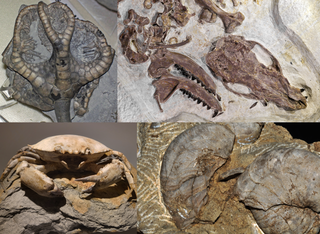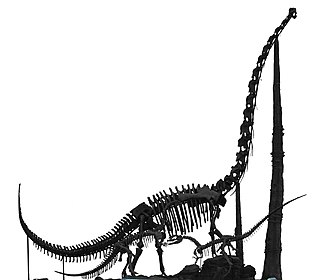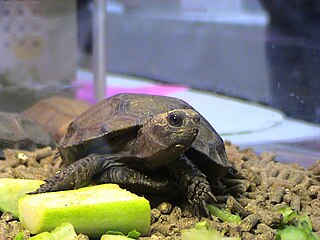
A chordate is an animal belonging to the phylum Chordata. All chordates possess, at some point during their larval or adult stages, five distinctive physical characteristics (synapomorphies) that distinguish them from other taxa. These five synapomorphies are a notochord, a hollow dorsal nerve cord, an endostyle or thyroid, pharyngeal slits, and a post-anal tail. The name "chordate" comes from the first of these synapomorphies, the notochord, which plays a significant role in chordate structure and movement. Chordates are also bilaterally symmetric, have a coelom, possess a circulatory system, and exhibit metameric segmentation.

A fossil is any preserved remains, impression, or trace of any once-living thing from a past geological age. Examples include bones, shells, exoskeletons, stone imprints of animals or microbes, objects preserved in amber, hair, petrified wood and DNA remnants. The totality of fossils is known as the fossil record.

Felidae is the family of mammals in the order Carnivora colloquially referred to as cats. A member of this family is also called a felid. The term "cat" refers both to felids in general and specifically to the domestic cat.
Panthera is a genus within the family Felidae that was named and described by Lorenz Oken in 1816 who placed all the spotted cats in this group. Reginald Innes Pocock revised the classification of this genus in 1916 as comprising the tiger, lion, jaguar, and leopard on the basis of common cranial features. Results of genetic analysis indicate that the snow leopard also belongs to the genus Panthera, a classification that was accepted by IUCN Red List assessors in 2008.

The gastropods, commonly known as slugs and snails, belong to a large taxonomic class of invertebrates within the phylum Mollusca called Gastropoda.

Incertae sedis or problematica is a term used for a taxonomic group where its broader relationships are unknown or undefined. Alternatively, such groups are frequently referred to as "enigmatic taxa". In the system of open nomenclature, uncertainty at specific taxonomic levels is indicated by incertae familiae, incerti subordinis, incerti ordinis and similar terms.
Acipenser is a genus of sturgeons. With 17 living species, it is the largest genus in the order Acipenseriformes. The genus is paraphyletic, containing all sturgeons that do not belong to Huso, Scaphirhynchus, or Pseudoscaphirhynchus, with many species more closely related to the other three genera than they are to other species of Acipenser. They are native to freshwater and estuarine systems of Eurasia and North America, and most species are threatened. Several species also known to enter near-shore marine environments in the Atlantic, Arctic and Pacific oceans.

Chuanjiesaurus is a genus of sauropod dinosaurs from the middle Jurassic Period. They lived in what is now China. The type species, Chuanjiesaurus anaensis, was first described by Fang, Pang, Lü, Zhang, Pan, Wang, Li and Cheng in 2000. Fossils of the species were found in the village of Chuanjie, Lufeng County, Yunnan Province, and are named after the location where the fossils were discovered. Holtz gave a length of 25 meters.

Macrochelys is a genus of very large freshwater turtles in the family Chelydridae, native to the Southeastern and Midwestern United States. Only a single extant species was recognized until 2014, when a study divided it into two, or possibly three species. These turtles are easily recognized by three distinct dorsal ridges with raised spikes.

Tremacebus is an extinct genus of New World monkeys from the Early Miocene. The type species is T. harringtoni.

The Majoidea are a superfamily of crabs which includes the various spider crabs.

Manouria is a genus of tortoises in the family Testudinidae. The genus was erected by John Edward Gray in 1854.

Boselaphini is a tribe of bovines. It contains only two extant genera, each with a single extant species.
Pratifelis is an extinct genus of feline that lived in North America during the middle Miocene period. It contains a single species, Pratifelis martini.

Erymidae is a family of decapod crustaceans known only from fossils. They survived for 100 million years, from the Permo-Triassic boundary to the Albian. Eleven genera are recognised:
Iaceornis is a prehistoric marine bird genus endemic to North America during the Late Cretaceous living about 83.5 mya. It is known from a single fossil specimen found in Gove County, Kansas (USA), and consisting of a partial skeleton lacking a skull.

Palaeomedusa testa is an extinct species of thalassochelydian turtle from the Tithonian of the Late Jurassic. It was first described by the German palaeontologist Christian Erich Hermann von Meyer in 1860. It is the only species classified under the genus Palaeomedusa.

The Cretaceous–Paleogene (K–Pg) extinction event, also known as the Cretaceous–Tertiary(K–T)extinction, was a sudden mass extinction of three-quarters of the plant and animal species on Earth, approximately 66 million years ago. The event caused the extinction of all non-avian dinosaurs. Most other tetrapods weighing more than 25 kilograms also became extinct, with the exception of some ectothermic species such as sea turtles and crocodilians. It marked the end of the Cretaceous Period, and with it the Mesozoic era, while heralding the beginning of the Cenozoic era, which continues to this day.

Tasbacka is an extinct genus of sea turtle containing several species.
Hypericum holyi is an extinct species of the genus Hypericum that was present from the Lower Miocene to the Upper Miocene. Fossil seeds of the species have been found in Central Europe in general and Central Jutland, Denmark, in particular.















